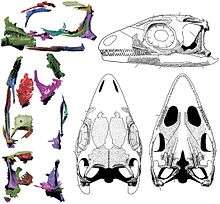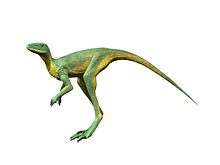Ozimek volans
Ozimek is a genus of sharovipterygid protorosaur, a type of gliding Triassic archosauromorph reptile from Poland closely related to the Kyrgyzstani Sharovipteryx. It contains one species, O. volans, named in 2016 by Dzik and Sulej.[1]
| Ozimek | |
|---|---|
 | |
| Skeletal diagram | |
| Scientific classification | |
| Kingdom: | Animalia |
| Phylum: | Chordata |
| Class: | Reptilia |
| Order: | †Protorosauria |
| Family: | †Sharovipterygidae |
| Genus: | †Ozimek Dzik & Sulej, 2016 |
| Species: | †O. volans |
| Binomial name | |
| †Ozimek volans Dzik & Sulej, 2016 | |
Description

Ozimek was a small animal, with a length of about 90 centimetres (35 in).[2] Its limbs were long, with the hindlimbs being generally longer than the forelimbs, and its feet were large. The limbs likely supported a membrane of skin that was used for gliding between trees, much like the similarly proportioned Sharovipteryx.[3][4] While the forelimbs of the latter are unknown, they were likewise probably similar to those of Ozimek.[1]
The skull of Ozimek is relatively fragmentary; from the identifiable fragments, the skull appears to have been diapsid, broad, and compact, with the jugal bone forming a complete arch. The preserved portions of the jaw show numerous small, sharp teeth. There appear to have been 9 cervical vertebrae, 16 dorsal vertebrae, 3 sacral vertebrae, and at least 7 caudal vertebrae (the tail is incompletely preserved). The cervical vertebrae are very elongated and thinly-walled, with the fourth, fifth, and sixth being the longest. Several gastralia are preserved; they suggest that the underside of the animal was gently convex.[1]
The most unique aspect of Ozimek's anatomy is perhaps its coracoids, which probably fused with the sternum. They are large and plate-like, and each coracoid bears two holes (or fenestrae); the anterior hole may be homologous with the coracoid foramina found in other animals, but the origin of the posterior hole is unclear. Additionally, the scapula is low and crescent-shaped, and the fifth metatarsal on the foot is curved and unusually robust, a feature that is associated with efficiently standing up and accelerated locomotion among diapsids (analogous to the mammalian heel).[5][1]
Discovery and naming

Ozimek is known from the mudstone and claystone beds of the Krasiejów quarry in Poland. The layers of rock exposed in this quarry, based on comparisons with other sites, dates to the Late Carnian, approximately 230 million years ago.[6] It is known from the holotype specimen, a partial, articulated skeleton catalogued as ZPAL AbIII/2512, along with four other articulated skeletons and 30 other fragmentary specimens.[1]
The genus name, Ozimek, is derived from Ozimek, the nearby town of the same name. The species name volans (Latin "flying") refers to its possible gliding lifestyle.[1]
Classification
The long neck of Ozimek resembles that of other derived members of the Protorosauria;[7] in particular, it shares many of the characteristics of Sharovipteryx, which was the basis of its assignment to the group Sharovipterygidae[3] in 2016. On the contrary, its robust fifth metatarsal on the foot is reminiscent of the more derived archosauromorphs Azendohsaurus[8] and Prolacerta.[9][1]
A 2019 phylogenetic analysis incorporating Ozimek found it as a member of the Tanystropheidae, as a close relative of Langobardisaurus and Tanytrachelos. This may suggest that both Ozimek and Sharovipteryx are members of the clade.[10]
Paleoecology
The Krasiejów quarry represents a lacustrine environment; the long neck and gliding membrane of Ozimek presumably was an adaptation to hunting insects in the surrounding forest. Other large vertebrates from Krasiejów include the aquatic Metoposaurus and Parasuchus, as well as the terrestrial Stagonolepis, Silesaurus, Cyclotosaurus, and Polonosuchus.[6][1]
References
- Dzik, J.; Sulej, Tomasz (2016). "An early Late Triassic long-necked reptile with a bony pectoral shield and gracile appendages" (PDF). Acta Palaeontologica Polonica. 64 (4): 805–823.
- "To przełomowe odkrycie! Największy latający gad odnaleziony na terenie Polski" [Groundbreaking discovery! The largest flying reptile found in Poland]. National Geographic Poland (in Polish). 28 November 2016. Retrieved 28 November 2016.
- Unwin, D.M.; Alifanov, V.R.; Benton, M.J. (2000). "Enigmatic small reptiles from the Middle–Late Triassic of Kyrgyzstan". In Benton, M.J.; Shishkin, M.A.; Unwin, D.M.; Kurochkin, E.N. (eds.). The Age of Dinosaurs in Russia and Mongolia. Cambridge: Cambridge University Press. pp. 177–186.
- Dyke, G.J.; Nudds, R.L.; Rayner, J.M.V. (2006). "Flight of Sharovipteryx mirabilis: the world's first delta-winged glider". Journal of Evolutionary Biology. 19 (4): 1040–1043. doi:10.1111/j.1420-9101.2006.01105.x. PMID 16780505.
- Lee, M.S.Y. (1997). "The evolution of the reptilian hindfoot and the homology of the hooked fifth metatarsal". Journal of Evolutionary Biology. 10 (2): 253–263. doi:10.1046/j.1420-9101.1997.10020253.x.
- Dzik, J.; Sulej, T. (2007). "A review of the early Late Triassic Krasiejów biota from Silesia, Poland" (PDF). Palaeontologia Polonica. 64.
- Sues, H.-D.; Fraser, N.C. (2010). Triassic Life on Land: The Great Transition. New York: Columbia University Press. ISBN 9780231509411.
- Nesbitt, S.J.; Flynn, J.J.; Pritchard, A.C.; Parrish, J.M.; Ranivoharimanana, L.; Wyss, A.R. (2015). "Postcranial Osteology of Azendohsaurus madagaskarensis (?Middle to Upper Triassic, Isalo Group, Madagascar) and its Systematic Position Among Stem Archosaur Reptiles". Bulletin of the American Museum of Natural History. 398: 1–126. doi:10.1206/amnb-899-00-1-126.1.
- Camp, C.L. (1945). "Prolacerta and the protorosaurian reptiles; Part I". American Journal of Science. 243 (1): 17–32. doi:10.2475/ajs.243.1.17.
- Pritchard, A.C.; Sues, H.-D. (2019). "Postcranial remains of Teraterpeton hrynewichorum (Reptilia: Archosauromorpha) and the mosaic evolution of the saurian postcranial skeleton". Journal of Systematic Palaeontology. 17 (20): 1745–1765. doi:10.1080/14772019.2018.1551249.









